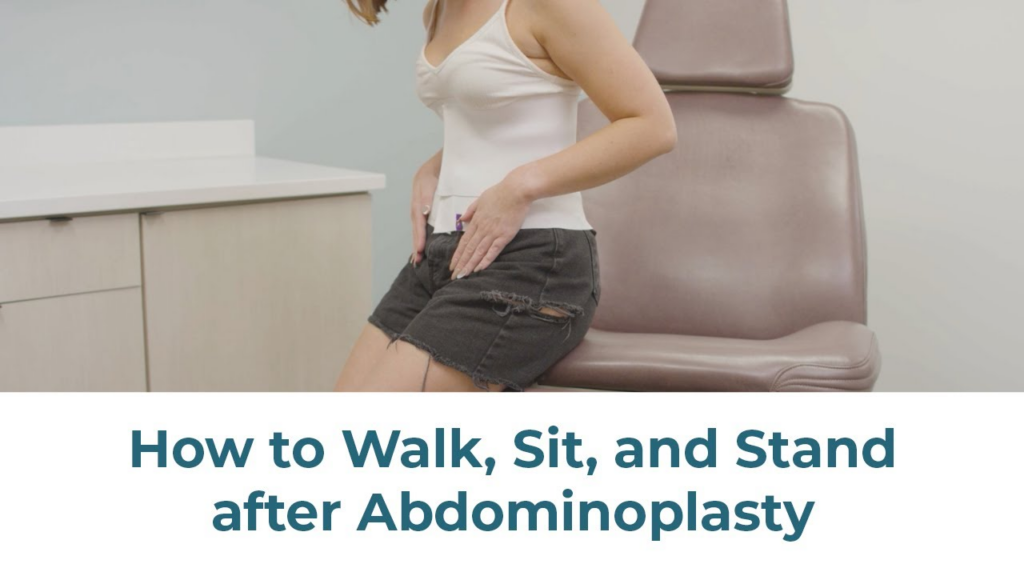A tummy tuck can remove loose, excess skin and fat, and tighten weak fascia. A tummy tuck may also remove stretch marks and excess skin in the lower abdomen below the bellybutton. However, a tummy tuck won’t correct stretch marks outside of this area.
After surgery, it’s important not to panic and to allow your body to heal at its own natural pace. The first week or two can be challenging, especially when it comes to bathing. It’s recommended to opt for sponge baths or use a chair while showering during this time. By following these precautions, you can ensure a smooth recovery process. After two weeks, you will start to notice improvements and be able to walk straight again. Remember to be patient with yourself and listen to your body as it heals.

Worst Days After Tummy Tuck
The worst days after your tummy tuck will be the first one to three days. You may experience some discomfort, bloating, pressure, and swelling, but these symptoms are normal and will resolve themselves. It’s important to rest as much as you can during this time, with short five minutes walks around the room or house every hour to keep your blood circulating. To help ease discomfort during these days, it is recommended to sit up in a reclined position or according to your surgeon’s directions.
Ensure you are well-hydrated and staying on a consistent pain schedule with your medication to help you relax and sleep, as this is when your body does its most healing.
Risks
A tummy tuck poses various risks, including:
- Fluid accumulation beneath the skin (seroma). Drainage tubes left in place after surgery can help reduce the risk of excess fluid. Your doctor might also remove fluid after surgery using a needle and syringe.
- Poor wound healing. Sometimes areas along the incision line heal poorly or begin to separate. You might be given antibiotics during and after surgery to prevent an infection.
- Unexpected scarring. The incision scar from a tummy tuck is permanent, but it’s typically placed along the easily hidden bikini line. The length and visibility of the scar varies from person to person.
- Tissue damage. During a tummy tuck, fatty tissue deep within your skin in the abdominal area might get damaged or die. Smoking increases the risk of tissue damage. Depending on the size of the area, tissue might heal on its own or require a surgical touch-up procedure.
- Changes in skin sensation. During a tummy tuck, the repositioning of your abdominal tissues can affect the nerves in the abdominal area, and infrequently, in the upper thighs. You’ll likely feel some reduced sensation or numbness. This usually diminishes in the months after the procedure.
Like any other type of major surgery, a tummy tuck poses a risk of bleeding, infection and an adverse reaction to anesthesia.
How You Prepare
You’ll talk to a plastic surgeon about a tummy tuck. During your first visit, your plastic surgeon will likely:
- Review your medical history. Be prepared to answer questions about current and past medical conditions. Talk about any medications you’re taking or have taken recently, as well as any surgeries you’ve had.Tell your doctor if you are allergic to any medications. If your desire for a tummy tuck is related to weight loss, your doctor will likely ask detailed questions about your weight gain and loss.
- Do a physical exam. To determine your treatment options, the doctor will examine your abdomen. The doctor might also take pictures of your abdomen for your medical record.
- Discuss your expectations. Explain why you want a tummy tuck, and what you’re hoping for in terms of appearance after the procedure. Make sure you understand the benefits and risks of the procedure, including scarring. Keep in mind that previous abdominal surgery might limit your results.
Before a tummy tuck you might also need to:
- Stop smoking. Smoking decreases blood flow in the skin and can slow the healing process. In addition, smoking increases the risk of tissue damage. If you smoke, your doctor will recommend that you stop smoking before surgery and during recovery.
- Avoid certain medications. You’ll likely need to avoid taking aspirin, anti-inflammatory drugs and herbal supplements, which can increase bleeding.
- Maintain a stable weight. Ideally, you’ll maintain a stable weight for at least 12 months before having a tummy tuck. If you’re severely overweight, your doctor will recommend that you lose weight before the procedure. Significant weight loss after the procedure can diminish your results.
- Arrange for help during recovery. Make plans for someone to drive you home after you leave the hospital and stay with you for at least the first night of your recovery at home.
When can I walk straight after tummy tuck?
Most patients are able to walk up-right within 2 weeks. Some patients may take longer. At my clinic, we do encourage the patients to try to walk upright after about 1 week.
When can I stand straight after tummy tuck?
Usually, after 1-2 weeks after tummy tuck, you are able to stand straight, Each patient is different, and your body on its own will straighten when you are ready. Some patients take longer up to 3 weeks to fully stand straight.
Tips to standing straight after tummy tuck
During abdominoplasty, the tissues are pulled tight at the waste line. It’s important to maintain a bent over, or jackknifed position when standing and when walking for the first week or so. As the tissues begin to heal, it is safe to achieve a more straight position.
However, this jackknifed position is critical for the first week, even when attempting to sit or lie down. The knees should be lifted, the feet and the head should maintain an elevated position, whether it’s with pillows or with a recliner chair. This protects the incision and protects the abdominoplasty results.
When can I bend over after tummy tuck?
The short answer is: you can start bending over after your tummy tuck.
The long answer is: it depends on the type of tummy tuck you had, how much time has passed since your surgery, and how well you’ve healed.
If you had a traditional tummy tuck, where a surgeon removes excess skin and fat from the abdomen, you can start bending over at about six weeks post-op. If you had a mini-tuck or brachioplasty surgery (where only your lower belly is removed), it might be closer to eight weeks post-op before it’s safe to bend over without damaging your incision line or causing complications.
It’s important to remember that there are many factors that can impact how quickly or slowly healing occurs. These include: your age; the extent of your body mass index (BMI); the type and location of incisions; whether or not fat grafting was performed; if there were any complications following surgery; and if any drains were used in the healing process.
As always, check with your doctor before attempting any activity that could potentially cause harm or injury!
When will my stomach feel normal after tummy tuck?
Let’s be honest…A tummy tuck is a big operation and you can expect it to take a couple of months before you get back to normal. There are many types of tummy tucks, and the recovery time can vary depending on the extent of the surgery.
Tummy tuck recovery stages
Below, you’ll find a handy timeline for what to expect after tummy tuck surgery. Again, keep in mind the extent of your surgery can vary. For example, a mini tummy tuck is far less invasive than an extended Sculpt tummy tuck, which means a shorter recovery time. Your mileage may vary.
Now that we’ve said that, let’s dive into a typical tummy tuck recovery timeline that you may find useful as you prepare for tummy tuck surgery:
Week 1: This is no doubt the most difficult part of tummy tuck recovery. Tummy tuck pain, swelling and even bruising are common.You may even regret having a tummy tuck. Don’t worry – these feelings are normal and this, too, shall pass.
You’ll be walking bent over at this point, and will be spending most of your time resting from the comfort of your bed or sofa. Walking every day is vital to recovery. Even just a few minutes every few hours can help.
Driving is off limits for the first 2-3 weeks.
At the 7 day mark, you will come in for a follow-up appointment. Dr. Beldholm will change the PICO dressings. Click here to learn the benefits of PICO negative pressure dressings.
Week 2: The worst is behind you. You’ll still have some discomfort, but it will decrease day by day. Swelling is still prevalent. Numbness in the lower abdomen is also normal. Your tummy still feels tender, so you will likely still need help around the house from friends, family members or an aid. By day 10, most patients will start walking upright. You’re doing great. Hang in there!
Week 3: Congrats! Most patients are allowed to start driving after a tummy tuck at 2 to 3 weeks. Now that you can drive, it frees you up to have a lot more independence. You’ll still need assistance carrying heavy groceries, etc. at this point, though. By now, you should be feeling a lot better overall.
Swelling, discomfort and bruising will decrease greatly by this stage.
The lower tummy will most likely still be numb and feel a bit “alien” for the time being. That’s because the sensory nerves in the skin were damaged during surgery (this is normal, after all, you just had surgery). Feeling will return eventually. Numbness usually subsides within 3 months as the nerves repair themselves.
Week 4: Most patients return to work around 4 weeks post-op. Returning to work signals how far you have made it in recovery. It also helps patients feel good knowing they are back in a familiar routine, so you will start to feel more “normal” again.
Week 5-8: Each day is easier and easier. You will be amazed at how far you have come in such a short time. The worst of the swelling will start going away 1 to 2 months after surgery. Most patients can resume a full exercise routine at the 8-week mark.
Exercising after tummy tuck is beneficial. It not only shows how far you have come physically, but exercise can also improve your tummy tuck results by keeping you fit and healthy. You’ll also be able to handle lifting heavy objects like groceries without assistance, which makes life easier.
Week 9: You’ve made it to the 3-month mark. This is when most of Dr. Beldholm’s patients say they really start feeling “back to normal”. Some swelling will still be present, but it will be substantially less than it was a few weeks ago. There shouldn’t be any pain or discomfort at this stage and you will be completely independent. The scars will still be red at this stage. It can take a long time for surgical scars to mature.
In the weeks and months that follow, you will notice swelling reduce even more. As the swelling settles, your tummy tuck results will become more visible. It’s amazing to see the transformation that takes place.
Remember, just a few months ago you had a totally different body with loose skin and unwanted fat that made you feel pretty low. Clothes will fit better now, and you will start feeling more like yourself as you get used to your beautiful, flat tummy.
How long until I see the results of a tummy tuck?
Getting a tummy tuck is a big landmark in many patients’ lives. It is no wonder that they feel both excited and anxious to see the results of surgery. After all, it took a lot of time and effort finding the right surgeon, taking time off work, arranging rides to doctor appointments, etc. Not to mention, the cost of tummy tuck surgery.
After all that, of course patients wish they could see results right away. The truth is, you will see a noticeable improvement immediately after surgery. That unwanted loose skin and fat will finally be gone for good. But — and this is a BIG “but” — it takes a while to see the final results because of the swelling after surgery.
In Doctor Bernard’s experience, 12 to 18 months is how long it takes to see the final results of tummy tuck surgery. However, you will feel “normal” again by the 3-month mark.
Tummy tuck scar fading is usually what takes the longest. (Hint: If you want to fade tummy tuck scars faster, try Laser Genesis to reduce scar redness.)
Is a tummy tuck covered by insurance?
Although there are certainly medical and functional benefits to be gained through a tummy tuck, the procedure is not typically covered by insurance. Some related procedures, such as the panniculectomy – which is used to remove the excess skin of the pannus after weight loss – may be covered by insurance in certain cases.
Can I combine a tummy tuck with other procedures?
Yes! Many patients choose to combine their tummy tuck with additional procedures in order to maximize the results of their transformation as well as to cut down on expensive surgical fees in the long run. After weight loss patients may choose to have a tummy tuck, arm lift (brachioplasty), and thigh lift all performed simultaneously, for instance.
Another example of a combined procedure is the mommy makeover, which can be highly beneficial for women who have had children – and even those who haven’t. Some of the procedures most commonly combined with a tummy tuck as part of a mommy makeover include breast augmentation, breast lift, and Brazilian butt lift (BBL).


